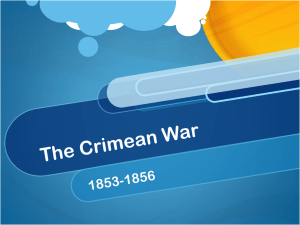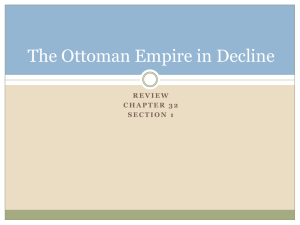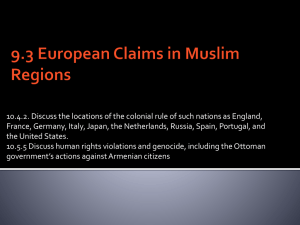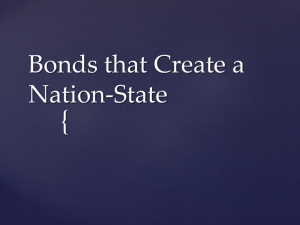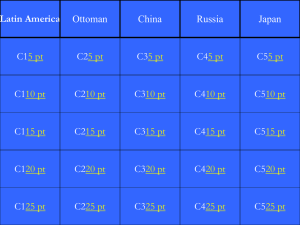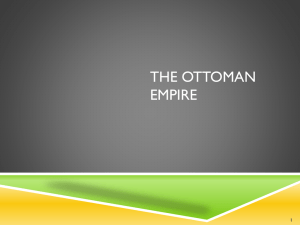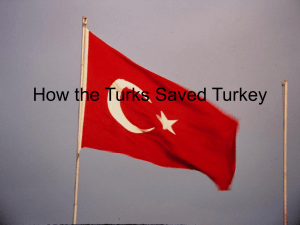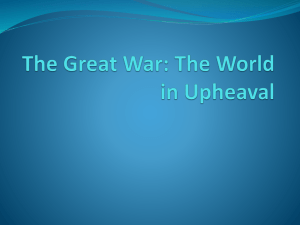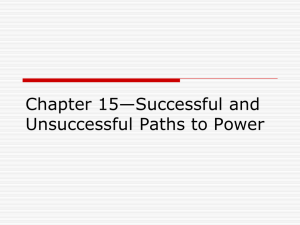Ch 19 Review Packet
advertisement
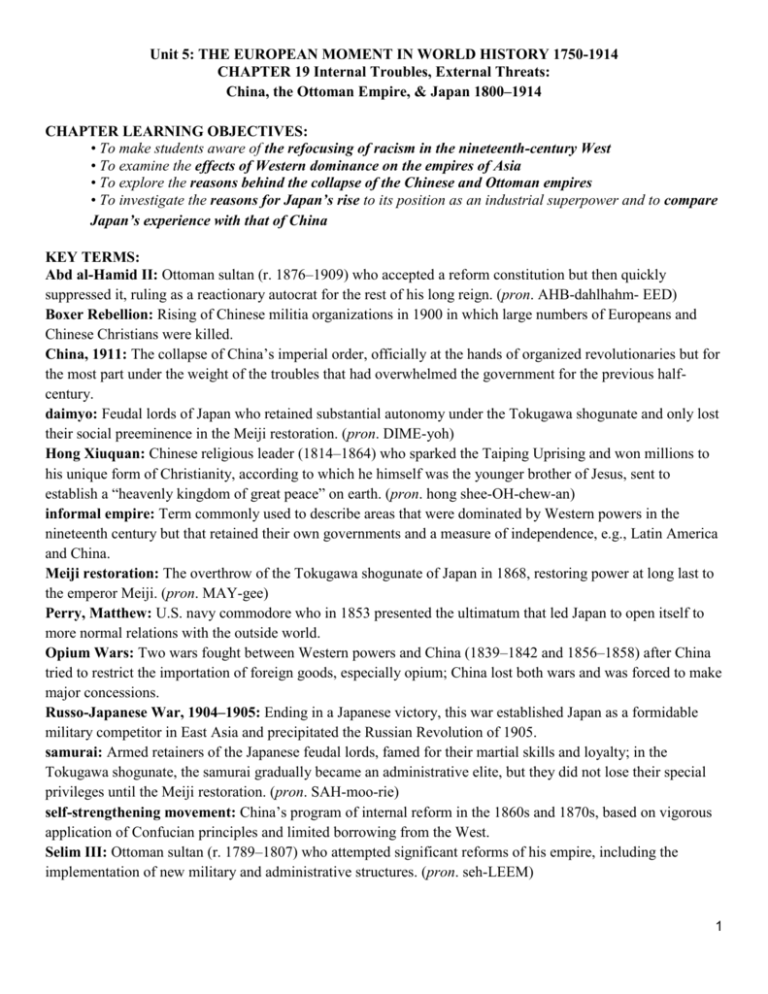
Unit 5: THE EUROPEAN MOMENT IN WORLD HISTORY 1750-1914 CHAPTER 19 Internal Troubles, External Threats: China, the Ottoman Empire, & Japan 1800–1914 CHAPTER LEARNING OBJECTIVES: • To make students aware of the refocusing of racism in the nineteenth-century West • To examine the effects of Western dominance on the empires of Asia • To explore the reasons behind the collapse of the Chinese and Ottoman empires • To investigate the reasons for Japan’s rise to its position as an industrial superpower and to compare Japan’s experience with that of China KEY TERMS: Abd al-Hamid II: Ottoman sultan (r. 1876–1909) who accepted a reform constitution but then quickly suppressed it, ruling as a reactionary autocrat for the rest of his long reign. (pron. AHB-dahlhahm- EED) Boxer Rebellion: Rising of Chinese militia organizations in 1900 in which large numbers of Europeans and Chinese Christians were killed. China, 1911: The collapse of China’s imperial order, officially at the hands of organized revolutionaries but for the most part under the weight of the troubles that had overwhelmed the government for the previous halfcentury. daimyo: Feudal lords of Japan who retained substantial autonomy under the Tokugawa shogunate and only lost their social preeminence in the Meiji restoration. (pron. DIME-yoh) Hong Xiuquan: Chinese religious leader (1814–1864) who sparked the Taiping Uprising and won millions to his unique form of Christianity, according to which he himself was the younger brother of Jesus, sent to establish a “heavenly kingdom of great peace” on earth. (pron. hong shee-OH-chew-an) informal empire: Term commonly used to describe areas that were dominated by Western powers in the nineteenth century but that retained their own governments and a measure of independence, e.g., Latin America and China. Meiji restoration: The overthrow of the Tokugawa shogunate of Japan in 1868, restoring power at long last to the emperor Meiji. (pron. MAY-gee) Perry, Matthew: U.S. navy commodore who in 1853 presented the ultimatum that led Japan to open itself to more normal relations with the outside world. Opium Wars: Two wars fought between Western powers and China (1839–1842 and 1856–1858) after China tried to restrict the importation of foreign goods, especially opium; China lost both wars and was forced to make major concessions. Russo-Japanese War, 1904–1905: Ending in a Japanese victory, this war established Japan as a formidable military competitor in East Asia and precipitated the Russian Revolution of 1905. samurai: Armed retainers of the Japanese feudal lords, famed for their martial skills and loyalty; in the Tokugawa shogunate, the samurai gradually became an administrative elite, but they did not lose their special privileges until the Meiji restoration. (pron. SAH-moo-rie) self-strengthening movement: China’s program of internal reform in the 1860s and 1870s, based on vigorous application of Confucian principles and limited borrowing from the West. Selim III: Ottoman sultan (r. 1789–1807) who attempted significant reforms of his empire, including the implementation of new military and administrative structures. (pron. seh-LEEM) 1 “sick man of Europe, the”: Western Europe’s unkind nickname for the Ottoman Empire in the nineteenth and early twentieth centuries, a name based on the sultans’ inability to prevent Western takeover of many regions and to deal with internal problems; it fails to recognize serious reform efforts in the Ottoman state during this period. social Darwinism: An application of the concept of “survival of the fittest” to human history in the nineteenth century. Taiping Uprising: Massive Chinese rebellion that devastated much of the country between 1850 and 1864; it was based on the millenarian teachings of Hong Xiuquan. (pron. tie-PING) Tanzimat reforms: Important reform measures undertaken in the Ottoman Empire beginning in 1839; the term “Tanzimat” means “reorgani-zation.” (pron. TAHNZ-ee-MAT) Tokugawa shogunate: Rulers of Japan from 1600 to 1868. (toe-koo-GAH-wah SHOW-gun-at) unequal treaties: Series of nineteenth-century treaties in which China made major concessions to Western powers. Young Ottomans: Group of would-be reformers in the mid-nineteenth-century Ottoman Empire that included lower-level officials, military officers, and writers; they urged the extension of Westernizing reforms to the political system. Young Turks: Movement of Turkish military and civilian elites that developed ca. 1900, eventually bringing down the Ottoman Empire. MARGIN REVIEW QUESTIONS: 1. In what ways did the Industrial Revolution shape the character of nineteenth-century European imperialism? 2. What contributed to changing European views of Asians and Africans in the nineteenth century? 3. What accounts for the massive peasant rebellions of nineteenth-century China? 4. How did Western pressures stimulate change in China during the nineteenth century? 5. What strategies did China adopt to confront its various problems? In what ways did these strategies reflect China’s own history and culture as well as the new global order? 6. What lay behind the decline of the Ottoman Empire in the nineteenth century? 7. In what different ways did the Ottoman state respond to its various problems? 8. In what different ways did various groups define the Ottoman Empire during the 19th century? 9. How did Japan’s historical development differ from that of China and the Ottoman Empire during the nineteenth century? 10. In what ways was Japan changing during the Tokugawa era? 11. In what respects was Japan’s nineteenth-century transformation revolutionary? 12. How did Japan’s relationship to the larger world change during its modernization process? BIG PICTURE QUESTIONS: 1. How did European expansion in the nineteenth century differ from that of the early modern era (see Chapters 14–16)? 2. What differences can you identify in how China, the Ottoman Empire, and Japan experienced Western imperialism and confronted it? How might you account for those differences? 3. “The response of each society to European imperialism grew out of its larger historical development and its internal problems.” What evidence might support this statement? 4. What kind of debates, controversies, and conflicts were generated by European intrusion within each of the societies examined in this chapter? 2

